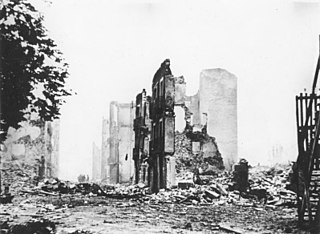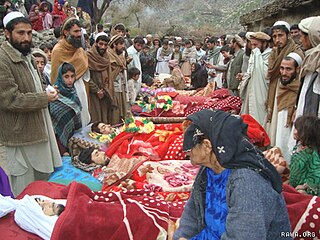
The aerial bombing of cities is an optional element of strategic bombing, which became widespread in warfare during World War I. The bombing of cities grew to a vast scale in World War II and is still practiced today. The development of aerial bombardment marked an increased capacity of armed forces to deliver ordnance from the air against combatants, military bases, and factories, with a greatly reduced risk to its ground forces. The killing of civilians and non-combatants in bombed cities has variously been a deliberate goal of strategic bombing, or unavoidable collateral damage resulting from intent and technology. A number of multilateral efforts have been made to restrict the use of aerial bombardment so as to protect non-combatants and other civilians.

Mullah Abdul Salam Zaeef is an Afghan diplomat who was the Afghan ambassador to Pakistan before the US invasion of Afghanistan.
Operation Eagle Fury was a military operation led by the United States in Afghanistan involving Bravo Company and two Charlie Company SFODAs, 2nd BN, 7th SFG(A) US Army Special Forces, and a sniper team of USN SEALs, members of the QRF 82nd Airborne Division, and loyal Afghan fighters from 9–28 February 2003. The aim of the operation was to corner Taliban fighters and leaders in the Bahgran Valley, located in Helmand Province, in the mountains of south-east Afghanistan. The battle took place in the village of Lejay for 43 consecutive hours. This continues to be the longest solely Special Forces battle to take place during the Afghanistan war.
Raes Abdul Wahed(also transliterated as Abdul Rais Wahid and Abdul Wahid) is an Afghan warlord.

Mullah Abdul Rauf Aliza, widely identified as Mullah Abdul Rauf Khadim, was a Taliban member held in extrajudicial detention in the United States Guantanamo Bay detention camp, in Cuba, until 20 December 2007. His Guantanamo Internment Serial Number was 108.

Sabar Lal Melma was a citizen of Afghanistan who was held in extrajudicial detention in the United States Guantanamo Bay detainment camps, in Cuba. Sabar Lal Melma's Guantanamo Internment Serial Number was 801. American intelligence analysts estimate that Sabar Lal Melma was born in 1962, Darya-e-Pech, Afghanistan.

Operation Mountain Fury was a NATO-led operation begun on September 16, 2006 as a follow-up operation to Operation Medusa, to clear Taliban insurgents from the eastern provinces of Afghanistan. Another focus of the operation was to enable reconstruction projects such as schools, health-care facilities, and courthouses to take place in the targeted provinces.

Musa Qala is a town and the district centre of Musa Qala District in Helmand Province, Afghanistan. It is located at 32.4433°N 64.7444°E and at an altitude of 1,043 m in the valley of Musa Qala River in the central western part of the district. Its population has been reported in the British press to be both 2,000 and 20,000. It is in a desolate area, populated by native Pashtun tribes.
The following lists events that happened during 2004 in Afghanistan.
Events from the year 2007 in Afghanistan.

The Helmand province campaign was a series of military operations conducted by the International Security Assistance Force (ISAF) forces against Taliban insurgents and other local groups in the Helmand Province of Afghanistan. Their objective was to control a province that was known to be a Taliban stronghold, and a center of opium production. None of the ISAF's intended strategic and political objectives were achieved in the long term.
The Battle of Musa Qala was a British-led military action in Helmand Province, southern Afghanistan, launched by the Afghan National Army and the International Security Assistance Force (ISAF) against the Taliban on 7 December 2007. After three days of intense fighting, the Taliban retreated into the mountains on 10 December. Musa Qala was officially reported captured on 12 December, with Afghan Army troops pushing into the town centre.

A skirmish occurred on the morning of February 10, 2003 outside Lejay, a small village in the northern, mountainous part of Helmand Province, Afghanistan. The village is in the Baghran valley, and one of the few highways in Afghanistan passes through it. American intelligence analysts assert that the village is the focus of the Opium Trade.
Operation Kamin was an offensive launched by Taliban insurgents in May 2007 which aimed to kill American-backed government forces and foreign troops in Kandahar.

Operation Strike of the Sword or Operation Khanjar was a US-led offensive in Helmand province in southern Afghanistan. About 4,000 Marines from the 2nd Marine Expeditionary Brigade as well as 650 Afghan troops were involved, supported by NATO planes. The operation began when units moved into the Helmand River valley in the early hours of July 2, 2009. This operation was the largest Marine offensive since the Battle of Fallujah in 2004. The operation was also the biggest offensive airlift by the Marines since the Vietnam War.

The night raid onNarang was a night raid on a household in the village of Ghazi Khan in the early morning hours of December 27, 2009. The operation was authorized by NATO and resulted in the death of ten Afghan civilians, most of whom were students, and some of whom were children. The status of the deceased was initially in dispute with NATO officials claiming the dead were Taliban members found with weapons and bomb making materials, while some Afghan government officials and local tribal authorities asserted they were civilians.
Events in the year 2017 in Afghanistan.












